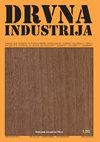Klasifikacija vrsta drva prema slikama uz pomoć dvodimenzionalne konvolucijske neuronske mreže
IF 0.8
4区 农林科学
Q4 MATERIALS SCIENCE, PAPER & WOOD
引用次数: 0
Abstract
The woodworking industry’s recognition and classification of timber is essential for trade, production and timber science. Traditional methods of identifying wood types are complex, time-consuming, costly and require expertise in wood science. Traditional techniques have been replaced by convolutional neural networks (CNNs), a deep learning tool to better identify wood species. In contrast to earlier studies that used pretrained models, a novel architecture designed explicitly for the WOOD-AUTH dataset was proposed in this study to develop a new 2D CNN model. The data collection encompasses high-level visual representations of 12 distinct types of timber. It is aimed to create a simpler and faster model as an alternative to time-consuming and heavy wood classification models. Compared to previous studies, this research worked with a newly structured 2D CNN network based on 12 wood species. High accuracy and fast computation time were achieved using fewer numbers (three layers) of the convolutional neural network. The proposed model achieved 94 % accuracy, 87 % precision, 81 % recall, 80 % F1 score and 112 minutes 27 seconds computation time. The 2D CNN model performed better than the transfer learning models regarding training epochs. The primary benefit of the model is its ability to achieve high accuracy with lower computation time, even at high epochs compared to other models. The introduced 2D CNN model produced satisfactory outcomes for wood species classification.利用二维卷积神经网络从图像中对木材类型进行分类
木工行业对木材的识别和分类对贸易、生产和木材科学至关重要。识别木材类型的传统方法复杂、耗时、成本高,而且需要木材科学方面的专业知识。卷积神经网络(CNN)取代了传统技术,这是一种深度学习工具,可以更好地识别木材种类。与早期使用预训练模型的研究不同,本研究提出了一种明确针对 WOOD-AUTH 数据集设计的新型架构,以开发新的二维 CNN 模型。数据集包含 12 种不同类型木材的高级可视化表示。其目的是创建一个更简单、更快速的模型,以替代费时费力的木材分类模型。与之前的研究相比,本研究使用了基于 12 种木材的新结构二维 CNN 网络。使用较少数量(三层)的卷积神经网络实现了较高的准确率和较快的计算时间。所提出的模型达到了 94 % 的准确率、87 % 的精确率、81 % 的召回率、80 % 的 F1 分数和 112 分 27 秒的计算时间。在训练历时方面,二维卷积神经网络模型的表现优于迁移学习模型。与其他模型相比,该模型的主要优点是能够以较低的计算时间获得较高的准确率,即使在较高的历时下也是如此。引入的二维 CNN 模型在木材种类分类方面取得了令人满意的结果。
本文章由计算机程序翻译,如有差异,请以英文原文为准。
求助全文
约1分钟内获得全文
求助全文
来源期刊

Drvna Industrija
MATERIALS SCIENCE, PAPER & WOOD-
CiteScore
1.80
自引率
9.10%
发文量
32
审稿时长
>12 weeks
期刊介绍:
"Drvna industrija" ("Wood Industry") journal publishes original scientific and review papers, short notes, professional papers, conference papers, reports, professional information, bibliographical and survey articles and general notes relating to the forestry exploitation, biology, chemistry, physics and technology of wood, pulp and paper and wood components, including production, management and marketing aspects in the woodworking industry.
 求助内容:
求助内容: 应助结果提醒方式:
应助结果提醒方式:


